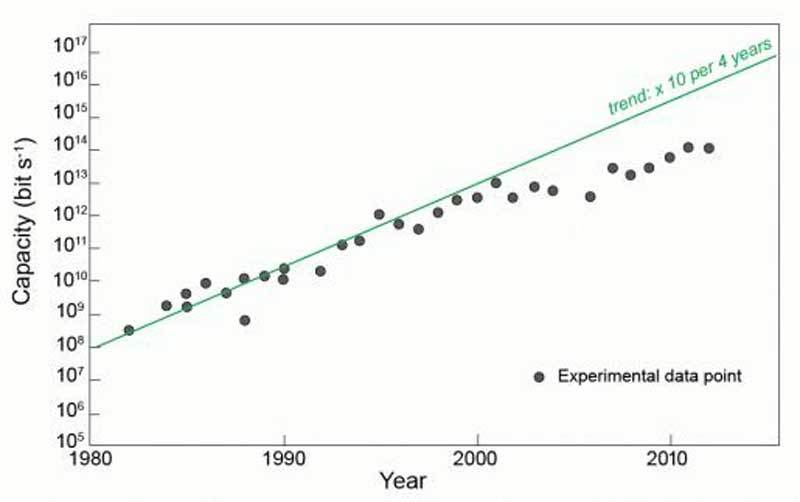Improving optical fiber bandwidth by a factor of ten
 EPFL scientists have shown how to achieve a dramatic increase in the capacity of optical fibers. Instead trying to redesign the fiber itself, they decided to improve multiplexing – a method which allows sharing of a communications channel or medium by combining signals at a common point. The breakthrough could increase the throughput of data in telecommunications systems by a factor of ten.
EPFL scientists have shown how to achieve a dramatic increase in the capacity of optical fibers. Instead trying to redesign the fiber itself, they decided to improve multiplexing – a method which allows sharing of a communications channel or medium by combining signals at a common point. The breakthrough could increase the throughput of data in telecommunications systems by a factor of ten.
EPFL’s Camille Brès and Luc Thévenaz reduced the space between pulses by fitting them together. This enables use of virtually all the capacity of an optical fiber. Unlike other solutions which require changes to the fibers themselves, the approach from EPFL researchers requires change of transmitters in between the fibers. Their breakthrough is based on a method that can produce a signal that strongly resembles Nyquist sinc pulses.
“These pulses have a shape that’s more pointed, making it possible to fit them together, a little bit like the pieces of a jigsaw puzzle lock together”, said Brès, Principle Investigator at the EPFL’s Photonics Systems Laboratory (PHOSL). “There is of course some interference, but not at the locations where we actually read the data.”
The idea to stack signals together to boost optic fibers’ throughput isn’t new. However, the “puzzle” had never been “solved” before. The EPFL team used a simple laser and modulator to generate a pulse that is more than 99% perfect.
Practically speaking, the shape of pulse is determined by its spectrum. In this case, in order to be able to generate the “jigsaw puzzle”, the spectrum needs to be rectangular. This means that all the frequencies in the pulse need to be of the same intensity. Professors Brès and Thévenaz had this in mind when modulating their lasers.
Simple lasers we see all around us generally beam one color because they have one optical frequency with a very narrow spectrum. However, a modulator allows fine tuning of a laser in order to have other colors (optical frequencies). The result is a pulse composed of several different colors, with a larger spectrum.
However, this leads to another problem in most of the cases because the pulse’s main color tends to be more intense than the others. This means that signals can’t have the rectangular shape researchers envisioned. In order to achieve their goal, the team needed to adjust each optical frequency of the pulse to have the same intensity. Using a frequency comb to perform a series of subtle adjustments, the researchers managed to successfully generate pulses with nearly perfect rectangular spectrum.
The novel approach could easily be implemented into existing telecommunications-industry market. The technology is already mature, as well as 100% optic and relatively low-cost. In addition, EPFL researchers claim it could be fitted onto a simple chip.
For more information, you can read the paper published in the Nature Communications: “Optical sinc-shaped Nyquist pulses of exceptional quality” [1.4MB PDF].











Leave your response!